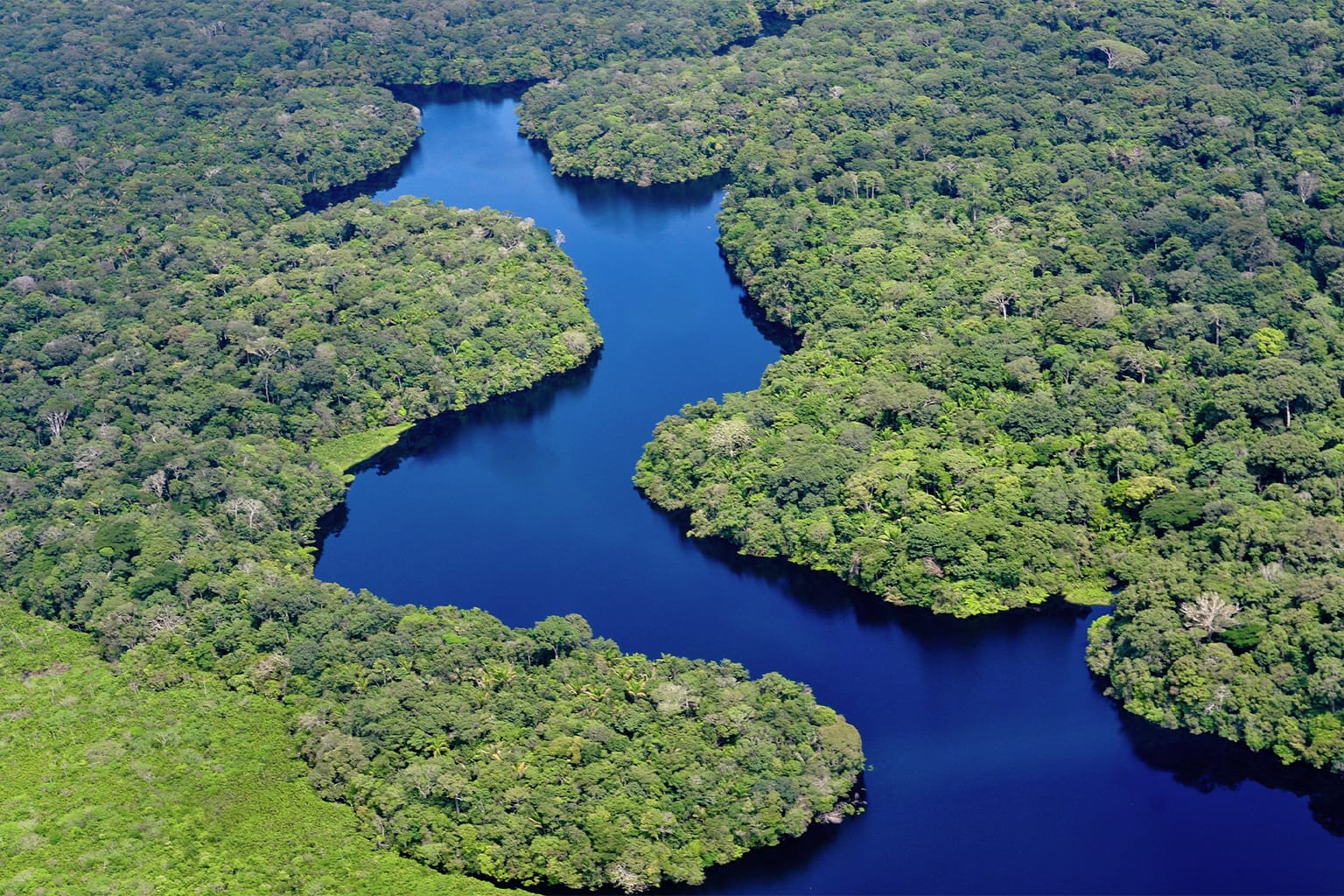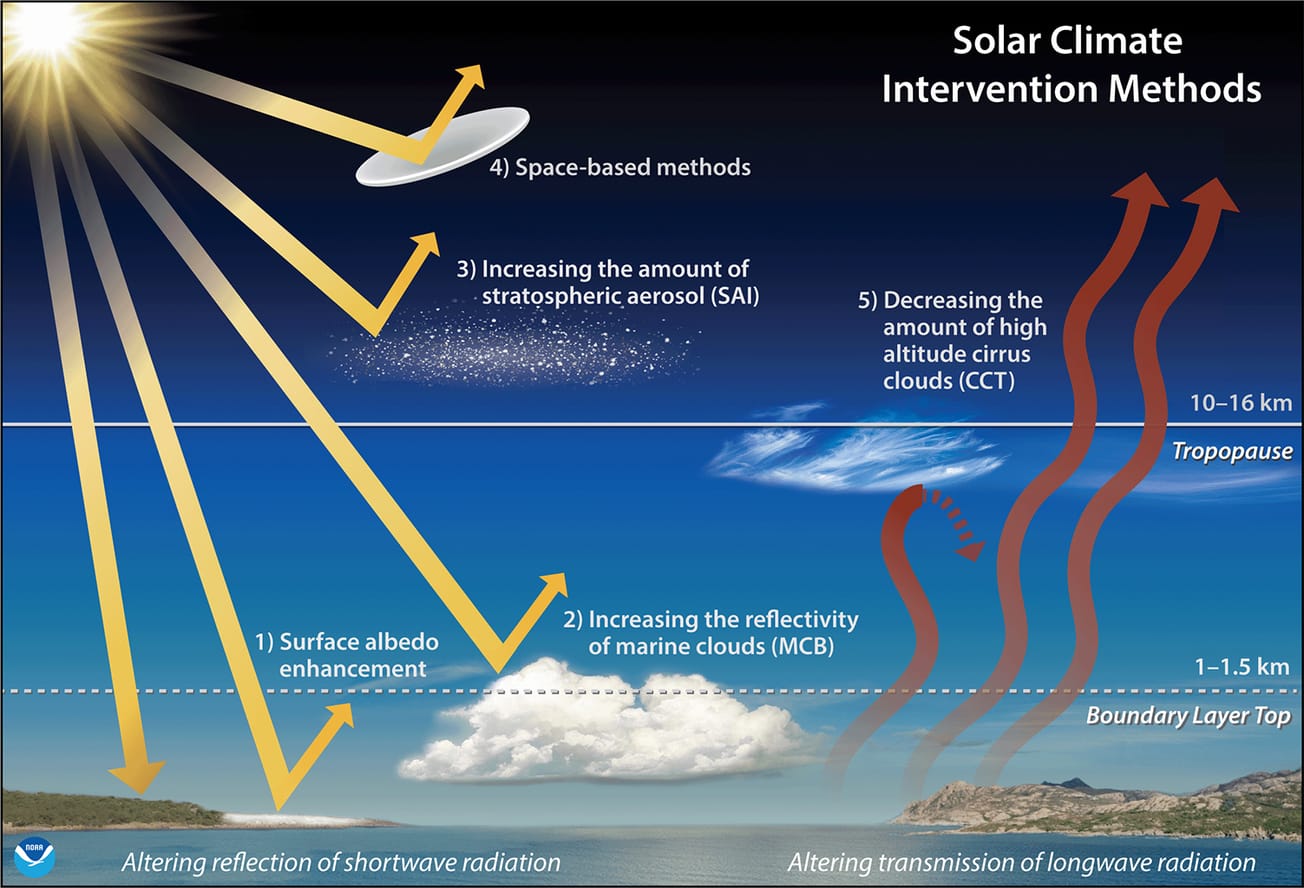Originally published on MongaBay, August 9th, 2024
As climate change rapidly advances, with 2023 and 2024 vying for the hottest year on record, solar radiation modification (SRM) geoengineering strategies are gaining momentum as short-term climate fixes. These especially include proposals for the release of cooling aerosols into the Earth’s lower stratosphere.
But preliminary geoengineering efforts (represented by lots of computer modeling and a smattering of small-scale field tests) are proceeding against a backdrop of public mistrust and resistance, while also provoking urgent calls by experts for national and international policies and regulatory structures to govern this burgeoning field.
Many analysts are truly concerned as to whether majorly tinkering with Earth’s atmosphere — physically altering the planet’s climate — can be governed in a just way, or accomplished at all by the world’s 195 nations, which barely ever agree on anything.
Who precisely, experts ask, will judge the worthiness of proposed geoengineering technologies and projects? Who will launch them, oversee and monitor them — and stop them if things go wrong?
Even the research community remains divided over geoengineering. Some scientists are vigorously advocating for objective and “responsible” research into the feasibility of various technologies, including stratospheric aerosol injection (SAI). But hundreds of academics recently signed a call for a Solar Geoengineering Non-Use Agreement, specifically targeting SAI.
Researchers and policymakers do broadly agree that governance is needed to safely and transparently guide small-scale field research projects and eventually regulate planetary deployment, if the world’s countries choose to go that route.

Global regulatory framework ‘completely insufficient’
Stratospheric aerosol injection is considered the most mature of a large suite of geoengineering approaches, and it could likely effectively cool the planet, with deployment plausible within the next decade or so, according to experts such as Andrea Hinwood, chief scientist with the United Nations Environment Programme (UNEP).
But planetary-scale SAI implementation raises environmental concerns over still poorly understood impacts on the ozone layer, climate change at regional levels, hydrology, biodiversity and ecosystems and human health.
A recent report published by UNEP includes SRM technologies as a potentially disruptive “signal of change” and warns that its deployment carries multiple and inherent risks to the environment and society writ large. “Recognizing that SRM technologies remain speculative and highly contentious, scientific scrutiny and more inclusive public discourse on the implications (including ethical issues) of SRM is critical at this stage,” the report reads.
Analysts are urging that international and national policies be negotiated now, with global oversight rules quickly put in place to prevent a single country or group of nations from pulling the trigger on SAI or other technologies, ushering in a new planetwide climate regime full of unknowns.
“I think that’s what we are worried about, and therefore governance of … these groups of technologies is critical,” Hinwood says. She co-authored a 2023 UNEP report on solar radiation modification outlining the risks and potential governance concerns, though she stresses that UNEP is not promoting such approaches or technologies.
“The regulatory framework is just completely insufficient … and I think that’s becoming more and more dangerous,” agrees Shuchi Talati, director of the Alliance for Just Deliberation on Solar Geoengineering, an NGO. She emphasizes that the “biggest problem” right now is the utter lack of coordinated governance structures for approving small-scale field experiments.

A ‘piecemeal … patchwork’ of policies
In 2021, the U.N General Assembly adopted a resolution seeming to address geoengineering without, however, specifically mentioning it. The body agreed then, “Activities aimed at intentional large-scale modification of the atmosphere should only be conducted [by nation states] with prudence and caution, and subject to any applicable rules of international law, including those relating to environmental impact assessment.”
But so far, the U.N. has taken no concrete action toward a geoengineering treaty. Lacking that, experts point to several existing international agreements that could set boundaries on the use of geoengineering techniques, including SAI. Among these is a 2010 decision by the Convention on Biological Diversity (CBD) that many say acts as a de facto moratorium. The CBD states that any climate-related geoengineering that could harm biodiversity should be off-limits “until there is an adequate scientific basis on which to justify such activities.”
Mary Church, geoengineering campaign manager at the Center for International Environmental Law, interprets this to mean that even small-scale field experiments could violate the CBD ruling. “Governments must act to uphold and enforce these agreements in national contexts, to send a clear signal that geoengineering is off limits,” she says.
But others question this strict reading of the CBD resolution. “This is one of the most misunderstood and misrepresented decisions in the field of SRM,” says Andy Parker, chief executive officer of the DEGREES Initiative, an NGO. “What the CBD decision said was that no SRM that would have significant adverse and transboundary impacts on biodiversity should proceed unless certain conditions are met,” which creates an opening for small-scale field research projects.
He also notes that the CBD agreement is not legally binding — a conundrum likely to hamper any future attempt to get all the world’s nations to agree on overarching geoengineering policies.

Other advisory bodies, such as the U.S. National Academy of Sciences, have proposed setting up transdisciplinary research programs focused on solar geoengineering, with the United States acting “in collaboration with other nations.” In addition, the U.S. government, UNEP and European Union have mandated research into governance of geoengineering in general or solar radiation modification in particular.
The European Union is actively investigating whether responsible science can be conducted into geoengineering and how those activities should be governed. But in February at a UNEP meeting, efforts by Switzerland to set up an international geoengineering research and scientific body failed, rebuffed by African nations, some of which called for a geoengineering “nonuse” agreement, out of fear of deployment inequities. As with past U.N. environmental negotiations, geoengineering is already seeing a regulatory tug-of-war between the Global North and Global South.
Searching for other global governance mechanisms, analysts point to the binding Montreal Protocol. “When it comes to stratospheric aerosol injection, there is the ozone protection regime, which does not mention SRM but states that you should avoid introducing things in the atmosphere that disturb the ozone layer,” notes Dana Ruddigkeit, researcher and policy adviser for Public International Law, with the German Environment Agency. Precisely how, or if, SRM might impact the ozone layer is still a matter of scientific debate.
“We have international legal principles like the ‘no harm principle,’ the precautionary principle, no transboundary harm to another’s territory, which would prevent any sort of unilateral deployment of solar geoengineering,” says Aarti Gupta, professor of global environmental governance at Wageningen University who backs a global nonuse agreement.
But taken all together, experts agree the current state of global geoengineering governance is “piecemeal” and a “patchwork” of restrictions and guidance that are vague and weak, leaving a glaring oversight gap that urgently needs to be addressed.

Controlling experimentation: ‘A little bit Wild West’
Thus far, the vast majority of stratospheric aerosol injection research has focused on modeling, work no one has opposed. But attempts at undertaking small-scale outdoor research and experimentation — vital to inform any future planetwide stratospheric intervention — remain mired in controversy.
In response to a controversial launch by a private U.S.-based company of a solar geoengineering test balloon over Mexican territory, that Latin American country announced its intention to ban all future geoengineering tests. Likewise, the U.S. state of Tennessee is implementing bans on testing, though the justification for this measure is mixed up with chemtrails conspiracy theory — an indication of the sort of public and official misinformation now guiding some geoengineering responses.
But these zealous outright prohibitions contrast drastically with extremely lax national regulations. Politico reports that the only requirement for a U.S. company or citizen intent on modifying the weather by injecting aerosols into the atmosphere is to fill out and file a one-page form with the National Oceanic and Atmospheric Administration (NOAA) 10 days before project start.
Similarly, in the United Kingdom, researchers launched “an engineering proof-of-concept” series of high-altitude solar engineering test balloons in 2022, deploying a basketball-sized 400-gram (less-than-1-pound) sphere of sulfate aerosols at high altitude. The “Stratospheric Aerosol Transport and Nucleation,” balloon systems (boasting the provocative acronym SATAN), were supposedly built from stock and hobbyist components, with hardware costing less than $1,000. The flights were launched with no prior notice or government approval. Though the effects were likely innocuous, the tests raised concern over transparency and the risk of triggering panic with the public.
The current experimentation situation is “a little bit Wild West,” says Max Holmes, president and CEO of the Woodwell Climate Research Center. He worries that in the absence of wider governance, the world could be plagued by a wave of geoengineering tech commercialization. “There’s the potential that while [field tests] are very small-scale right now, … [if] it ramps up in scale, that’s where it gets scary to me,” he says.
One such small-scale project by Harvard University, dubbed the Stratospheric Controlled Perturbation Experiment (SCoPEx), officially pulled the plug this year following years of controversy, which came on the back of a failed attempt to launch a controlled experiment in Sweden, in part due to a groundswell of local opposition.
“The ScoPEx project did an admirable job of establishing small-scale self-governance with a strong degree of independence,” Faye McNeill, professor of chemical engineering and Earth and environmental sciences at Columbia University, and Han Huynh, research scientist at CU-CIRES/NOAA, wrote in an email. Together they published a recent paper outlining SAI risks and need for governance. They warn, “[S]elf-governance is not sufficient for a technology that potentially impacts the environment and societies to the extent that SAI is intended to.”
The lack of global regulation, they say, creates a chicken-and-egg conundrum: Developing SAI will prove challenging without such experimentation conducted at the local level, but the absence of overarching rules and regulations is a roadblock to such tests.
“More public engagement, education and discussion prior to field experimentation could be helpful, but some of the fundamental distrust of this technology could come from the lack of independent governance at the [national] government or international level,” they wrote.
For small-scale research to move forward, experts say coordinated governance at the local and national levels are needed, including required environmental impact assessments, oversight, transparency on experimentation and funding, codes of conduct and more.
A 2024 report by the failed SCoPEx project’s independent advisory committee underlined the necessity early on of community engagement. Also, “From a governance perspective, it would be great to actually have a register of who’s doing what, and what those outcomes are,” Hinwood says.
Governing the ungovernable?
Geoengineering poses significant unforeseeable regional and global environmental risks. That being the case, analysts say, strong governance is required to ensure “responsible” research and experimentation.
This work, most say, should be in the hands of reputable scientific researchers and institutions, not profit-motivated companies. Further, a serious inclusive global discussion is needed to create a legal framework for geoengineering in general, and SAI in particular.
Currently, Parker says, no country has yet set a “gold standard” for such an approach.
Others, however, believe that a technology as contentious and potentially dangerous as SAI is unlikely to ever be governed effectively or democratically within existing international structures, meaning geoengineering should be removed from the table entirely.
“We cannot have a situation where a few major powers or a few countries decide when to deploy, how much to deploy, when to stop and what kind of global temperature we want,” Gupta says. The “enforceable governance of solar geoengineering deployment at the international level [that] is feasible, is very limited.”
In the end, the failure to cut carbon emissions, along with rapidly escalating climate change impacts, could leave the world’s nations with little choice but to respond with planetwide geoengineering. In preparation for that moment, governance discussions should start now, some experts say.
And as flawed as its record may be, the U.N. offers a potential forum for those discussions. With all 195 nations potentially impacted by a geoengineering fix, a binding and flexible international treaty similar to the Montreal Protocol needs to set boundaries on use. But as with the Paris Agreement, the devil will be in the details.

A fundamental point experts agree upon, no matter which side of the geoengineering divide they sit on: No matter which geoengineering technology is deployed, it will not end the climate crisis. At very best it could buy the world time to accomplish a global sustainability transformation.
“SRM and other geoengineering approaches are kind of nuts to be thinking about. But that’s where we are right now. I think it’s important that we understand if they’re a viable tool, if and when we might decide we need to use it,” Holmes says. “Of course, what we should be doing is putting the brakes on climate change [by] rapidly reducing emissions of greenhouse gases.”
Additional Credit
Editor - Glenn Scherer
Citations
Huynh, H. N., & McNeill, V. F. (2024). The potential environmental and climate impacts of stratospheric aerosol injection: A review. Environmental Science: Atmospheres, 4(2), 114-143. doi:10.1039/d3ea00134b
Wells, A. F., Henry, M., Bednarz, E. M., MacMartin, D. G., Jones, A., Dalvi, M., & Haywood, J. M. (2023). Identifying climate impacts from different stratospheric aerosol injection strategies in UKESM1. doi:10.22541/essoar.170365333.31848426/v1
Sun, W., Wang, B., Chen, D., Gao, C., Lu, G., & Liu, J. (2020). Global monsoon response to tropical and Arctic stratospheric aerosol injection. Climate Dynamics, 55(7-8), 2107-2121. doi:10.1007/s00382-020-05371-7
Zarnetske, P. L., Gurevitch, J., Franklin, J., Groffman, P. M., Harrison, C. S., Hellmann, J. J., … Yang, C. (2021). Potential ecological impacts of climate intervention by reflecting sunlight to cool earth. Proceedings of the National Academy of Sciences, 118(15). doi:10.1073/pnas.1921854118
Tracy, S. M., Moch, J. M., Eastham, S. D., & Buonocore, J. J. (2022). Stratospheric aerosol injection may impact global systems and human health outcomes. Elementa: Science of the Anthropocene, 10(1). doi:10.1525/elementa.2022.00047










